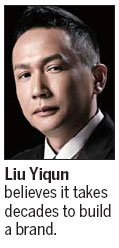Men's wear wolf in the pack
Updated: 2013-01-25 09:35
By Lv Chang (China Daily)
|
|||||||||||
|
Liu Yiqun, general manager and chief designer of Wolf Zone, poses at a studio in Beijing during China Fashion Week 2012 . Provided to China Daily |
Shishi fashion company balances business acumen and design prowess in hunt for international image
Chinese men's fashion doesn't stretch much beyond the Mao jacket or Zhongshan suit in the world's eyes. But for the past 15 years, since his time as an art student, Liu Yiqun has been tailoring ways to change that image.
In the process, as well as creating a fresh, distinctive and more casual style of men's wear, the Shishi-born designer has stitched a noted fashion label, Wolf Zone, on to China's growing collection of brands.
 |
Liu's latest collection graced the catwalk at the closing ceremony of China's Fashion Week in Beijing in October, and he's been invited to participate in the Who's Next in Paris showcase event this year during that city's fashion week. He has recently been rated as one of China's top 10 designers.
With 200 stores across China, Wolf Zone ranks as an entrepreneurial success as well as a design one. And therein lies the problem, albeit one that many up-and-coming fashion designers would wish to have.
After years of finding his way in the industry, 42-year-old Liu is still struggling to find a balance between his roles as designer and entrepreneur.
"There is a huge gap between your ideal product and the market," he says. "As a designer, I care about my products, whether we are using the best material to present my work, and I want to follow my heart. But as a businessman, I have to consider the cost and what the market needs."
More than half the world's fashion clothing is manufactured in China, with Liu's hometown, Shishi, the production base of casual wear in southern Fujian province.
While China has increasingly made clothes for European and American labels, a breed of homegrown designers such as Liu has sprung up and created a market for buyers looking for something different and not stereotypically Chinese.
"Chinese independent designers have been attracting attention from international buyers and media through fashion shows and all kinds of events," Liu says. "I think they are bridging the gap with the big foreign brands by reshaping themselves into innovative and unique figures in the fashion industry.
"Consumers have become more demanding and designers need to present a project that is original and versatile."
Wolf Zone, launched in 2004, posted a turnover of 100 million yuan ($16.1 million; 12.1 million euros) last year, and Liu plans to increase the number of stores to 300, spreading from southern China, where most are located, to the north of the country.
Liu opened his first store in 1997 while still a student majoring in art at Xiamen University in Fujian province. It was then he realized he was mostly interested in fashion design.
But, as for many independent designers, the startup money was a problem. Liu started to work as a fashion buyer and opened a multi-brand store where he also placed some of his personally designed jeans and T-shirts.
"At first I didn't tell clients those clothes were designed by me, because I was afraid that it would drive the brand-conscious customers away," he says.
"But later, as my stuff flew off the racks, and they became regular clients, I decided to tell them the truth. Surprisingly, they took it well and continued to support me."
By 2004, he had enough capital to start his own label and take on a new series of challenges in moving from being a fashion buyer to an independent designer.
"Setting up a new label involves endless work," he says. "You have to design the clothes, source fabrics, organize events, seek out buyers and do marketing. Each step was difficult."
He puts much of today's success down to his hands-on approach to the business. In the early years of Wolf Zone, he often worked late into the night, occasionally doubling up as tailor.
Wolf Zone works on a "light asset operation" business model that involves outsourcing most production and transportation requirements. It's an approach that helps the company focus on its core areas of design, marketing and distribution.
"It's been tested as the best business model and many Western designer brands like Armani and Versace are working that way," he says.
It has also led the company to set up more direct-sale shops and increase investment in logistics and factories.
Being a mid- to high-level range of men's clothing, Wolf Zone is favored by fashion-conscious young Chinese celebrities, who seek to stand out from the crowd. It competes well with Western brands such as Replay, Diesel and Energy. The price of a Wolf Zone pair of jeans ranges from 500 yuan to 3,000 yuan, depending on the fabrics and prints.
China's creative industry is still growing, with a market that seems more interested at present in fast fashion rather than fashion as art that reinvigorates the cultural beauty of the past.
But, says Liu, a brand such as Wolf Zone, which targets a small group of people, doesn't want to compromise quality and brand image to simply pursue higher profit.
"It's about whether you have a long-term vision," he says. "There are many designers who want to do things quickly. But from my perspective, it is important to have a certain amount of time to develop your style.
"In Milan, Paris and New York, brands are not made in one or two years. Instead, it needs decades to build a name. That process of creating a heritage is what we need to achieve distinction."
lvchang@chinadaily.com.cn
(China Daily 01/25/2013 page18)
Today's Top News
Police continue manhunt for 2nd bombing suspect
H7N9 flu transmission studied
8% growth predicted for Q2
Nuke reactor gets foreign contract
First couple on Time's list of most influential
'Green' awareness levels drop in Beijing
Palace Museum spruces up
Trading channels 'need to broaden'
Hot Topics
Lunar probe , China growth forecasts, Emission rules get tougher, China seen through 'colored lens', International board,
Editor's Picks

|

|

|

|

|

|






